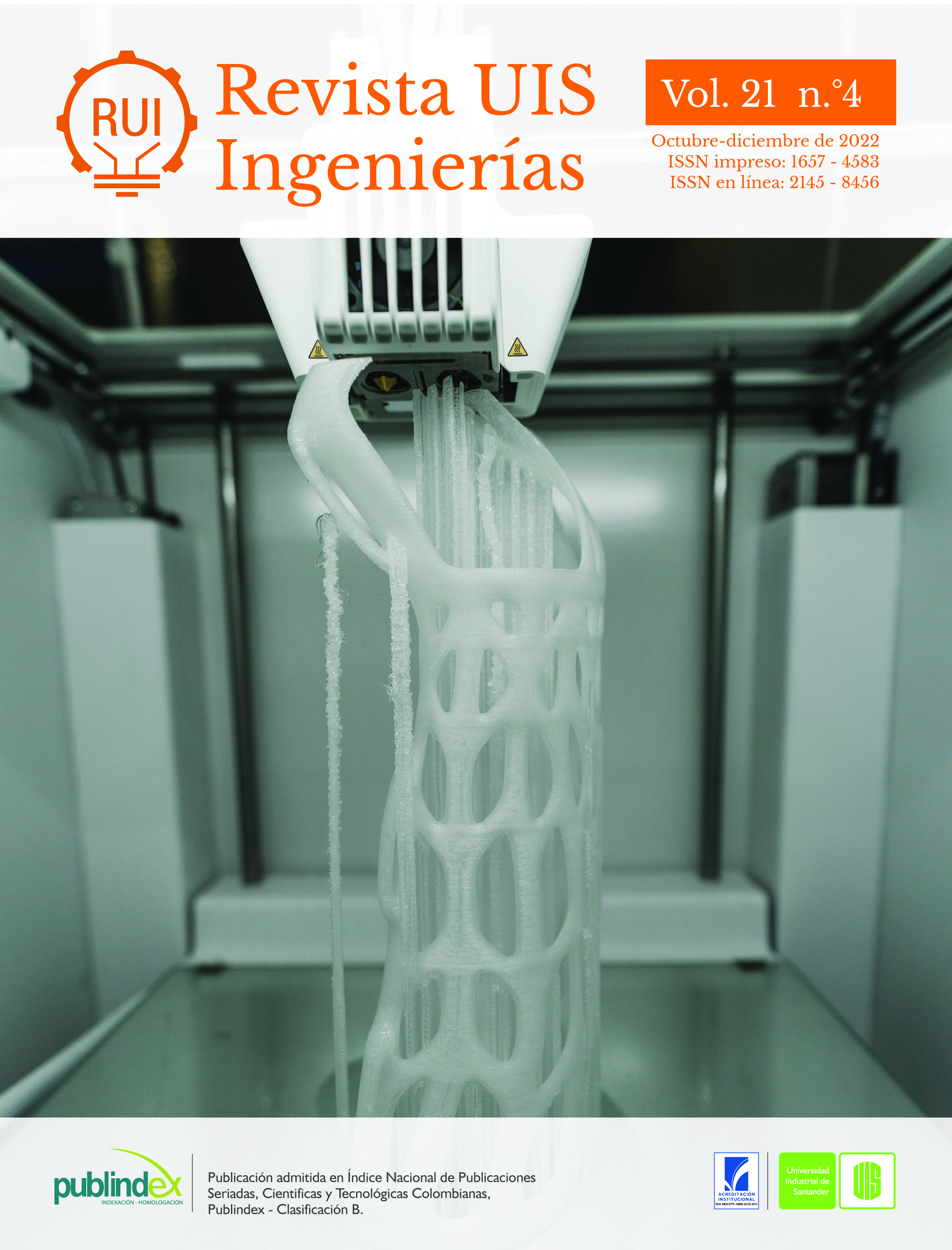Published 2022-10-30
Keywords
- hybrid Cuk converters,
- power electronics (PE) devices,
- differential equations,
- OpenModelica,
- voltage and current references
- capacitor,
- inductor,
- power switch,
- diode,
- energy ...More
How to Cite
Copyright (c) 2022 Revista UIS Ingenierías

This work is licensed under a Creative Commons Attribution-NoDerivatives 4.0 International License.
Abstract
This paper presents a methodology for obtaining the voltage and current references that permits the modelling of Hybrid Cuk (HC) Converters. The passive sign convention when system elements absorb energy is used to derive the differential equations governing the behaviour of the converter. This allows the explanation of the operation principle of the converter that is performed through the switching states. The behavior of the converter is studied by means of an energy interchange analysis between inductors and capacitors. After the deduction of the references and operating principle, the differential equations (DEs) that allow the modelling of the converter are deduced. Finally, a comparison between the mathematical model and the circuital representation of the converter is performed in OpenModelica for validation purposes. The simulations’ results allow to conclude that the obtained references and differential equations are coherent with the circuital implementation.
Downloads
References
- Z. Bi, W. Xia, “Modeling and simulation of dual-mode DC/DC buck converter,” in ICCMS 2010 - 2010 International Conference on Computer Modeling and Simulation, vol. 3, pp. 371–375, 2010, doi: http://doi.org.10.1109/ICCMS.2010.490
- E. Arango, C. Ramos-Paja, J. Calvente, R. Giral, S. Serna-Garces, “Asymmetrical Interleaved DC/DC Switching Converters for Photovoltaic and Fuel Cell Applications—Part 2: Control-Oriented Models,” Energies, vol. 6, no. 10, pp. 5570–5596, 2013, doi: http://doi.org.10.3390/en6105570
- J.-H. Urrea-Quintero, N. Muñoz-Galeano, L. M. Gómez-Echavarría, “Analysis and Control of Power Electronic Converters Based on a System Zero Locations Approach,” in Applied Modern Control, IntechOpen, 2019.
- T.-D. Duong, M.-K. Nguyen, T. T. Tran, Y. C. Lim, J.-H. Choi, “Transformerless High Step-Up DC-DC Converters with Switched-Capacitor Network,” Electronics, vol. 8, no. 12, p. 1420, 2019, doi: http://doi.org.10.3390/electronics8121420
- M. S. Martínez-García, A. de Castro, A. Sanchez, J. Garrido, “Analysis of Resolution in Feedback Signals for Hardware-in-the-Loop Models of Power Converters,” Electronics, vol. 8, no. 12, p. 1527, 2019, doi: http://doi.org.10.3390/electronics8121527
- P. Shaw, “Modelling and analysis of an analogue MPPT‐based PV battery charging system utilising dc–dc boost converter,” IET Renew. Power Gener., vol. 13, no. 11, pp. 1958–1967, 2019, doi: http://doi.org.10.1049/iet-rpg.2018.6273
- Yang, Zhang, Zhang, Tian, Hu, “Control Strategy of Mode Transition with Engine Start in a Plug-in Hybrid Electric Bus,” Energies, vol. 12, no. 15, p. 2989, 2019, doi: http://doi.org.10.3390/en12152989
- J. Liu, J. Hu, L. Xu, “Dynamic Modeling and Analysis of $Z$ Source Converter—Derivation of AC Small Signal Model and Design-Oriented Analysis,” IEEE Trans. Power Electron., vol. 22, no. 5, pp. 1786–1796, 2007, doi: http://doi.org.10.1109/TPEL.2007.904219
- S. Lica, I.-M. Pop-Calimanu, D. Lascu, S. Popescu, M. Tomoroga, A. Ciresan, “A New Hybrid Ćuk Converter,” in 2018 International Symposium on Electronics and Telecommunications (ISETC), pp. 1–4, 2018, doi: http://doi.org.10.1109/ISETC.2018.8583911
- B. Axelrod, Y. Berkovich, A. Ioinovici, “Switched-capacitor (SC)/switched inductor (SL) structures for getting hybrid step-down Cuk/Sepic/Zeta converters,” in 2006 IEEE International Symposium on Circuits and Systems, p. 4, doi: http://doi.org.10.1109/ISCAS.2006.1693770
- C. Restrepo, T. Konjedic, J. Calvente, M. Milanovic, R. Giral, “Fast Transitions Between Current Control Loops of the Coupled-Inductor Buck–Boost DC–DC Switching Converter,” IEEE Trans. Power Electron., vol. 28, no. 8, pp. 3648–3652, 2013, doi: http://doi.org.10.1109/TPEL.2012.2231882
- P. Fritzson et al., “The OpenModelica Integrated Modeling, Simulation, and Optimization Environment,” in Proceedings of the 13th International Modelica Conference, pp. 206–219, 2019, doi: http://doi.org.10.3384/ecp18154206
- A. M. Dizqah, A. Maheri, K. Busawon, P. Fritzson, “Standalone DC microgrids as complementarity dynamical systems: Modeling and applications,” Control Eng. Pract., vol. 35, pp. 102–112, 2015, doi: http://doi.org.10.1016/j.conengprac.2014.10.006
- A. Bartolini, F. Casella, A. Guironnet, “Towards Pan-European Power Grid Modelling in Modelica: Design Principles and a Prototype for a Reference Power System Library,” in Proceedings of the 13th International Modelica Conference, pp. 627–636, doi: http://doi.org.10.3384/ecp19157627
- D. Reid, “DQ rotating frame PI control algorithm for power inverter voltage regulation modelling and simulation using the OpenModelica platform,” in SoutheastCon, pp. 1–4, 2015, doi: http://doi.org.10.1109/SECON.2015.7132896
- M. A. A. Murad, L. Vanfretti, M. Rokonuzzaman, R. A. Tuhin, “Enhancing engineering studies in developing countries using OpenModelica,” in 2017 4th International Conference on Advances in Electrical Engineering (ICAEE), pp. 153–158, 2017, doi: http://doi.org.10.1109/ICAEE.2017.8255345

